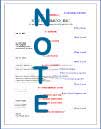ViaSyl -- Business Communication
Focus: Business Communications Formats
|
|
You are here: ReportsReports Reports, in an information age, are essential to business writing and written communications in general. What makes business reports different from general academic reports is a real-world, practical, problem-centered orientation. The emphasis is placed on brevity, clarity, and functionality. Reports are varied, each with some typical structural elements.
The categories included in a report depend on the subject or situation. All reports need to be complete and accurate with informational headings to explain the subject and enable a reader to make a decision. In detailed, technical reports, for example, among the headings you should probably include these or headings similar to the following:
In reports where strictly controlled specific research is not required, the organization may resemble that of a memo, and may include the following headings: I Background, II Current situation, III Solution (if applicable) IV Recommendation. Some informative reports, such as status reports, do not require a recommendation section. Quarterly or annual reports provide a sequential review of a specific time period, and although they may not include a recommendation, they may analyze the meaning of events in the time period covered and suggest future developments. As in any type of communication, format depends on purpose and on the needs of the audience. Use of headings in long reports are essential. The headings act as an internal outline, showing the reader the importance of each section. Consistency of headings will guide the reader through the categories of your report. Depending upon the level of formality, reports, typically, include some or all of the following eleven parts:
If you use MS Word (version 97 and up) you can explore these formats. Try them out . You'll find these and other templates provide you with a quick way to good design. Soon you will easily format your reports and your content will have the appearance to help get your message across. In addition, to further your report writing skills, check out the following Internet resources: Management library: This site has recommended headings for meeting reports, including information on participants, agenda, objectives, and action. It also gives pointers on reader-centered report construction. Claremont Graduate University Writing Center-- Here'll you'll get some help with any research-oriented reports: how to organize materials and work with sources. Check it out. |
 Microsoft has report templates for downloading
Microsoft has report templates for downloading